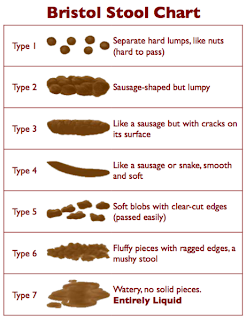
Poop - Poo - Stools - Crap - Feces - Faeces
and what they can show us, tell us and teach us.
Contents: What Poop color tells you -- What poops floating or sinking characteristics tell you -- Poop size does matter -- What poop texture tells you -- Conclusion on the importance of knowing your poop and knowing the poop of your children.
Yes, just about everything on poop that you didn't know who to ask about and maybe never would.
Just as we can tell much about a dinosaur from it's petrified poop, we can tell much about a human by the poop they poo out.
In spite of the topics weirdness, it is actually quite a serious topic, which can perhaps even save your life.
Knowing how to read your own poop, or the poop of your children, can help you understand what's going on with the intestines, liver and diet.
It may even alert you to some dangerous illnesses that cause blood to appear in the stool.
Poo - Poop - Crap - Stools - Feces - What their color tells you.
Yes, the color of your poop can tell you something about your general health.
Firstly, if your poop is a milk chocolate color, that's the best.
Black poops are warning bells - could be cancer and bleeding up in your intestines. See a doctor fast.
If the poop is too dark, that could again suggest a liver problem.
Yellow poop may suggest your liver is not producing enough bile for digesting food.
Yellow bits in your poop suggest you ate corn and that you are not chewing your food enough.
Green poop may mean your liver is overproducing bile, too much bile. Green poop could also mean you ate salads and green vegetables the day or two before.
Green poop may also mean you are not digesting your food very well - if this is the case your green poop will also contain bits of lettuce, silver beet, spinach or other green food stuffs. Apart from mango and watermelon, most fruits will be fully digested in a healthy digestion system - so if they show up in the poop, you may have a digestive problem.
Whitish, foggy areas on your poop may suggest liver problems - the fat in the food not being broken down fully.
Bright red suggests undigested blood in your stool, such as from internal hemorrhoids.
Dark red in poops suggests bleeding in the intestines which requires medical assessment fast.
Poo - Poop - Crap - Stools - Feces - What their floating or sinking characteristics tell you.
Vegetarians should have floating poop - veges produce gas that get caught in the poop, making the poop lighter than water.
Big meat and junk food eaters will often have floaters too. The poop contains fat, the fat is lighter than water, so the poop floats. This can also mean a liver problem, as the fat is not being broken down fully.
For those of us who eat both veges and meat, expect your poop to sink.
Poo - Poop - Crap - Stools - Feces - Size does matter.
The more you eat, the more you should be pooping.
Ideal poop is 6 to 10 inches in length - 15 to 25cm - pooping two to three out each sitting. Width not so important, as width of poop mostly determined by the width of your colon.
Poo - Poop - Crap - Stools - Feces - What the texture tells you.
Texture of poop is hard to describe. A poop that looks smooth or very rough suggests either poor digestion or poor diet. The ideal poop is in between.
Vegetables make stools soft, but if you have no veges and your stool is soft, then you may have a problem. Without veges the stools should be hard, which is good if you want constipation and resulting hemroids.
Diarrhea
Runny poop is a diarrhea and can be caused by a germ (virus or bacteria) or diet or other condition.
If it's a germ causing the runny poop, then keep the fluids up, like flat lemonade and avoid eating anything except dry toast or dry biscuits, like Jatz, which are most likely safe to eat.
If the runny poop is diet based, it more than likely means you are living on cereal just about. High sugar and lots of fiber. So cut down on the sugary stuff and give your body a chance - all that wiping could cause external hemroids.
If your runny poop is not a germ or diet, then you have a condition that requires medical assessment.
Conclusion on Poop
As you can clearly see, the color, buoyancy, texture and size of poop, all tells us something about your health, particularly about your diet, your digestive system, your liver and may alert us to other conditions, like cancer or typhoid fever, that one may be suffering from.
In spite of the strangeness of this topic, the information is none-the-less vital to know. It could easily save the life of yourself or of your child.






